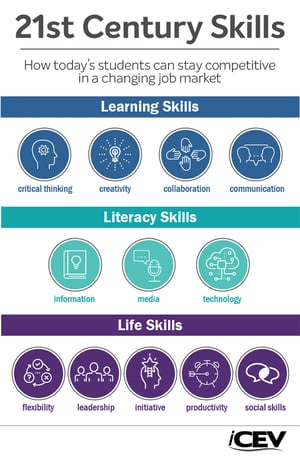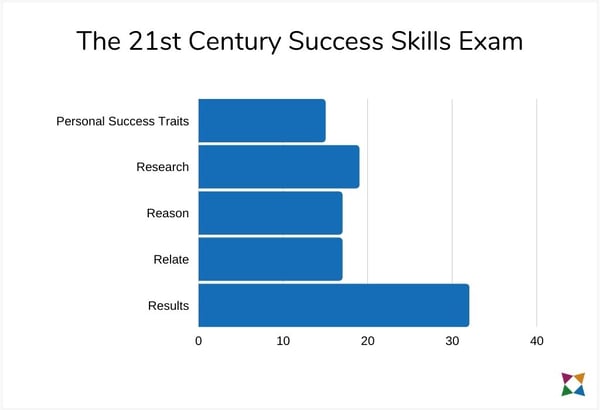Career Readiness | Middle School | 21st Century Skills
What Is the 21st Century Success Skills Exam?
As a career readiness curriculum developer, we speak with teachers on a weekly basis looking for assessment options that will help students demonstrate their mastery of career readiness skills.
One option these teachers ask us about is the 21st Century Success Skills exam from Precision Exams.
In this article, you’ll discover answers to four common questions that educators have about the 21st Century Success Skills exam:
- What are 21st Century Skills?
- What are the 21st Century Success Skills standards?
- What’s on the 21st Century Success Skills exam?
- How can I help my students learn 21st Century Skills?
After reading the article, you’ll have a clearer understanding of whether the 21st Century Success Skills exam is suitable for your students.
You'll also have an opportunity to download a free guide to teaching 21st Century skills, if it's an important topic for your classes.
Before diving into the specifics of the exam, let’s review what 21st Century skills are.
1. What Are 21st Century Skills?
Students need to learn how to adapt and overcome in an ever-changing workplace, and that’s where 21st Century skills come into play.

The twelve 21st Century skills are:
- Critical thinking
- Creativity
- Collaboration
- Communication
- Information literacy
- Media literacy
- Technology literacy
- Flexibility
- Leadership
- Initiative
- Productivity
- Social skills
By learning these 21st Century skills, your students will have the qualities they need to keep up with today’s evolving workplace.
Learn More: What Are 21st Century Skills and How do You Teach Them?
2. What Are the 21st Century Success Skills Standards?
The 21st Century Success Skills standards focus on fundamental personal traits, knowledge, and skills that are required for students to successfully transition from their schooling into the workforce.
There are five 21st Century Success Skills standards:
- Standard 1: Personal Success Traits
- Standard 2: Researching information to solve problems
- Standard 3: Critical Thinking and Objectively Analyzing Information
- Standard 4: Problem Solving by Relating Problems
- Standard 5: Communicating and Working with Others
Each standard contains key objectives for students to hit in order to be deemed successful.
These standards and objectives act as the foundation of what students need to know for the 21st Century Success Skills exam.
Let’s dive into the details of each standard so you know what concepts and skills you need to cover.
Standard 1: Personal Success Traits
In order to be proficient in this standard, candidates must be able to demonstrate personal traits that encourage productivity and employability in any situation.
There are seven objectives in Standard 1:
- Objective 1: Understand how a positive attitude affects the work environment.
- Objective 2: Understand how being self-motivated, self-disciplined and having a good work ethic impacts the work environment.
- Objective 3: Understand the importance of honesty and integrity in all situations.
- Objective 4: Understand the importance of dependability in all situations.
- Objective 5: Understand the role of respect in the work environment.
- Objective 6: Understand the importance of being adaptable and flexible in the work environment.
- Objective 7: Understand the importance of acting professionally in a work environment.
These skills are useful in isolation, but will also be useful in developing the skills necessary for subsequent standards.
Standard 2: Researching Information to Solve Problems
Research is a fundamental part of everyday life. In order to adequately display the skills required for this standard, students need to understand and demonstrate how to search for and locate information on any given subject.
There are three main objectives for Standard 2:
- Objective 1: Demonstrate how to ask the appropriate questions to get the required information.
- Objective 2: Understand how to gather and determine if information is relevant.
- Objective 3: Understand the ethical and legal issues surrounding the access and use of information.
Standard 3: Critical Thinking and Objectively Analyzing Information
In order to demonstrate success in this standard students must be able to think critically and objectively analyze information.
There are three main learning outcomes for Standard 3:
- Objective 1: Understand and demonstrate how to read, monitor, and interpret information presented in various formats or tools (i.e. news articles, charts, graphs, tables, gauges, dials, signs, controls).
- Objective 2: Apply critical thinking skills to objectively evaluate and analyze information.
- Objective 3: Demonstrate how to organize information for useful analysis.
Standard 4: Problem Solving by Relating Information
To be proficient in this standard, students will understand how to relate the analysis of information to different situations, and use this to solve problems.
There are two main learning outcomes for Standard 4:
Objective 1: Use creative thinking as part of the problem-solving process.
Objective 2: Apply the analysis of information to make decisions regarding the problem to be solved by identifying multiple solutions, analyzing consequences of those solutions, and making a decision based on the desired results.
Standard 5: Communicating and Working with Others
For Standard 5, students will know how to effectively communicate the decision and results made from analysis to others in order to achieve a desired outcome.
There are five main objectives for Standard 5:
- Objective 1: Understand how to effectively manage projects.
- Objective 2: Understand how to effectively communicate to others.
- Objective 3: Understand how to effectively and respectfully interact and collaborate (work) with others
- Objective 4: Identify the qualities of a good leader.
- Objective 5: Identify how to effectively lead a meeting.
3. What's on the 21st Century Success Skills Exam?
Earning a certificate is a great way for your students to demonstrate that they have mastered the necessary skills and knowledge laid out in the standards.
As the teacher, you need to ensure your students are ready to earn that certificate.
Because of this, you’re probably wondering: How do these standards relate to the 21st Century Success Skills exam?

The 21st Century Success Skills exam consists of 46 items, which are broken down according to the five standards:
- Personal Success Traits 15%
- Research (Research/Learn Information) 19%
- Reason (Analyze Information) 17%
- Relate (Apply Information to Situation) 17%
- Results (Do, Record, Act, Produce Outcome) 32%
By passing the exam, your students will demonstrate to future employers that they can successfully understand and implement the skills required to thrive in a modern work environment.
4. How Can I Help My Students Learn 21st Century Skills?
Now that you know what skills are required and what to expect from the exam, you probably have one last question: How do I help my students learn 21st Century skills?
While these skills can be taught at any grade level, we find it's most important and beneficial to teach 21st Century skills in middle or early high school. This is the perfect time to hone their career readiness skills, in preparation for their role in the working world.
To learn how you can incorporate 21st Century Skills into your curriculum and prepare your students for the exam, download the free guide to teaching 21st Century skills.

